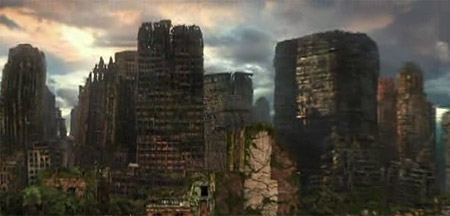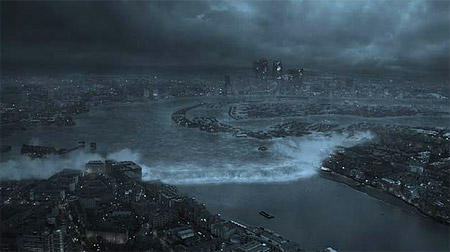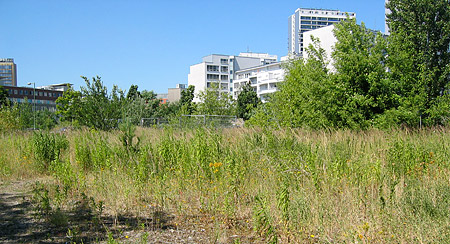Apocalypse Wow
All of a sudden, the apocalypse is good entertainment again. The recent film release of I am Legend, based on Richard Metheson’s novel of the same name, provides us with a morbid opportunity to delve into the fantasy of what a ferral urban environment might look like when humans are long gone.

Protagonist Robert Neville’s own personal ground zero is of course Manhattan, which has been repeatedly and gleefully destroyed on film on numerous occasions: When World’s Collide (flood), Ghost Busters II (paranormal slime), The Day After Tomorrow (tidal wave and megablizzard), Godzilla (angry reptile), Armageddon (slight meteorite damage), Deep Impact (tidal wave, again), Independence Day (aliens) and the upcoming Cloverfield (some indistinct entity) are just a few examples. New York Magazine’s entertainment blog «Vulture» recently posted the 10 Best Movie Destructions of New York complete with video clips, which helpfully reduces each film to its money shot.
I am Legend was a must-see: after all, the trailer promised scenes of Will Smith harvesting corn in central park, and hunting antelope on 5th Avenue. These sequences were fascinating, and didn’t dissapoint; unlike the film’s ending which was a predictably heinous turd. The thing which sets this narrative apart from the others though, is the timescale. Deep Impact’s kilometer-high tidal wave obliterates New York in 30 soggy seconds, but Legend’s depiction of gradual ruination progresses at an unperceivable bio-geological pace: fungus spreads, weeds grow taller, wild animals reclaim territory and things fall apart very, very slowly. It is a gritty reminder that what holds our towns and cities together is not just great feats of engineering, but boring daily maintenence.

Anti-architects with access to The History Channel will have some fun on the 21st Jan. with the premier of Life After People, a 2 hour «TV event» which asks «What would happen to planet earth if the human race were to suddenly disappear forever?» Apart from fish, whales and dolphins profiting enormously from the absense of human life, the effects on buildings are studied. Video clips on the programe’s website show university professor Ray Coppinger talking of «vertical ecosystems» when pondering the fait of abandoned skyscrapers.
This all puts me in mind of Mike Davis’ splendidly morbid essay «Dead Cities: A Natural History» published in 2002, in which the author references the 1886 novel After London: or, Wild England by Richard Jefferies. In it, Jeffries expounds his vision of the capital city, semi-submerged by a county-sized inland sea blocked by huge dams of debris piling up against the crumbling structures of «ancient bridges» crossing the Thames:
Thus the low-lying parts of the mighty city of London became swamps, and the higher grounds were clad with bushes. The very largest of the buildings fell in, and there was nothing visible but trees and hawthorns on the upper lands, and willows, flags, reeds, and rushes on the lower. These crumbling ruins still more choked the stream, and almost, if not quite, turned it back. If any water ooze past, it is not perceptible, and there is no channel through to the salt ocean. It is a vast stagnant swamp, which no man dare enter, since death would be his inevitable fate.

Amidst this fictional example of creeping urban decay, Mike Davis reminds us of the aftermath of the bombing of Berlin in World War II. He recalls the words of poet Gottfried Benn who observed nettles as «tall as men»; signs were put up on the Autobahn warning of wolves; 50 strong heards of wild boar «ravaged» the city’s periphery and British troops helped an emaciated population by hunting three species of deer who had moved into the Spandau forests in search of food.

Berlin’s few remaining bomb sites, such as SLAB’s oft mentioned inner-city prairie, are stark reminders of just how close an urban environment is to spiralling back to a wild natural environment. Gottfried Benn’s man-high nettles are no joke; last summer I was fascinated by a thistle in a nearby green spot which grew to a majestic 1.5 meters before it was mown away. According to the Senate Department for Urban Development, Berlin is home to almost 30.000 different plant and animal species, making it more biodiverse than the surrounding countryside. Without the constant efforts of this cash-strapped city, Berlin would return quickly to the swamp on which it was built.
Further decay:
Pripyat.com – Fascinating website about the abandoned town of Pripyat, not far away from Chernobyl. It’s been uninhabited for 20 years, and trees have taken over.
Detroit Public Schools Book Depository – in a building next to Michigan Central Station in downtown Detroit stands the rotting remains of a huge storage space for educational books. Gutted by fire and open to the elements, hundreds-of-thousands of textbooks have been left to decay.
Sweet Juniper – Blog post accompanying the Detroit photos.